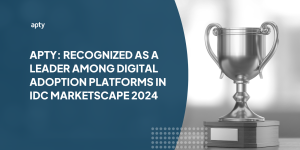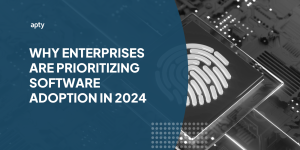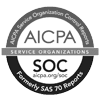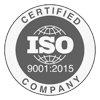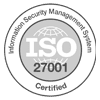Adaptability and innovation are crucial for companies aiming to stay ahead in a competitive and continuously changing market. Change management is pivotal for organizations seeking to adapt to market shifts and innovate. A detailed change management plan is essential, as it clarifies roles and the impact of changes on responsibilities and outlines the necessary steps for a seamless transition.
With nearly 50% of all organizational change initiatives falling short of their objectives, mastering change management is a vital skill for leadership. This highlights the need for a well-thought-out plan that reduces disruption and increases efficiency, ensuring organizations remain agile and aligned with strategic goals.
A change management plan details the approach an organization will take to move from current to new processes, identifying crucial roles and activities for effective change management. Whether adopting new technologies or modifying workflows, a concise plan supports a smooth transition, reducing interruptions and promoting organizational readiness.
The primary goal of a change management plan is to facilitate the adoption of significant changes efficiently and with minimal disruption, serving as a strategic blueprint for action. It guides teams through changes with clarity and confidence, ensuring the organization stays responsive and aligned with its strategic objectives.
The plan acts as a comprehensive guide for transformation by outlining the stages of implementation, including preparation, execution, and reinforcement. This detailed roadmap is key for addressing the human elements of change, aligning everyone with the new direction, and enabling them to contribute to the organization’s ongoing success.
What is a Change Management Plan?
A change management plan outlines the strategy and steps an organization will follow to implement changes effectively. It serves as a guide, ensuring the change process is smooth, minimizes workflow disruption, and supports the team adequately. Incorporating an organizational change model into the plan can delineate specific actions needed to execute changes across the company’s operations, highlighting the importance of a well-thought-out plan for successful change management.

eBook: Accelerate Change Management with a Digital Adoption Center of Excellence
Relevant Read: 15 Change Management Questions to Ask
Why You Need a Change Management Plan
Undergoing digital transformations requires a strategic, well-organized approach to manage the shift effectively and ensure that all parts of the organization move forward together. A change management plan is critical because it offers a structured roadmap for this transition. Such a plan is not just a document but a comprehensive strategy that outlines how changes will be communicated, implemented, and reinforced across the organization. It ensures that transitions are technically successful and embraced by the workforce, thereby enhancing the overall effectiveness and minimizing resistance or confusion.

The need for a change management plan stems from the inherent challenges of modifying processes, systems, or technologies. Without a clear strategy, organizations risk disruptions affecting operations, employee productivity, and customer satisfaction. A change management plan addresses these risks by preparing employees for change, providing clear instructions for each phase of the process, and establishing metrics for success. This preparation and foresight mean that businesses can maintain continuity, morale, and service levels during change, making the difference between a successful transformation and a costly setback.
Relevant Read: Organizational Change Management Strategies
When are Change Management Plans Needed?
Change management plans become crucial when organizations face significant shifts requiring systematic processes, systems, or technological adjustments. These moments can arise from various internal or external factors, such as organizational restructuring, mergers and acquisitions, technology upgrades, or shifts in market demands. Identifying the need for such a plan is the first step towards ensuring that changes are implemented smoothly and effectively, minimizing disruptions to operations and helping employees adjust to new ways of working.
The need for a change management plan often becomes apparent in response to stakeholder feedback, performance gaps identified through metrics, or as part of strategic planning processes. For example, launching a new product, entering a new market, or addressing regulatory changes necessitate a structured change management approach. Recognizing these triggers early on allows leadership to mobilize a structured response, ensuring that the organization adapts to new conditions and seizes opportunities for growth and improvement.
Delve More: Change Management Action Plan: The Complete Checklist for Enterprise Change Management
What is Included in a Change Management Plan?
A comprehensive change management plan is essential for guiding organizations through transitions smoothly and efficiently. This plan acts as a roadmap, detailing every critical step of the process, ensuring all employees are included and informed at every stage. Transparency is key to building trust and alignment among team members, even when not everyone might initially support or understand the need for change. The challenge lies in leading the organization confidently toward the desired outcome, leveraging your leadership skills to turn skepticism into commitment.
The core components of a change management plan include:
- Detailed Steps for Implementation: A step-by-step guide that outlines the specific actions required to implement the change effectively. This ensures everyone knows what is expected and when.
- Roles and Responsibilities: This clearly defines who is in charge of managing various aspects of the change. This clarity helps hold individuals accountable and ensures that all tasks are covered.
- Employee Training Programs: Plans for educating employees about the change, providing them with the necessary skills and knowledge to adapt to new processes or technologies.
- Consequences of Non-compliance: Describes what happens if the change is not implemented as planned. Understanding these consequences helps motivate compliance and illustrates the importance of the transition.
- Knowledge Transfer Process: Ensures that the organization shares valuable information effectively. This component is crucial for maintaining operational continuity and efficiency during and after the change.
Incorporating these elements into your change management plan creates a structured framework that prepares your organization for transition, addresses potential resistance, and fosters collaboration and openness. This strategic approach facilitates the change process and positions the organization for success in achieving its objectives.
Learn More: Organizational Change Management: How Digital Adoption Plays a Pivotal Role
Key Elements of a Change Management Plan
A robust change management plan is the cornerstone of a successful organizational transformation. Its effectiveness is determined by several key elements that, when combined, provide a comprehensive approach to managing change. These elements ensure that the organization navigates the transition smoothly and achieves its desired outcomes with minimal disruption to operations.
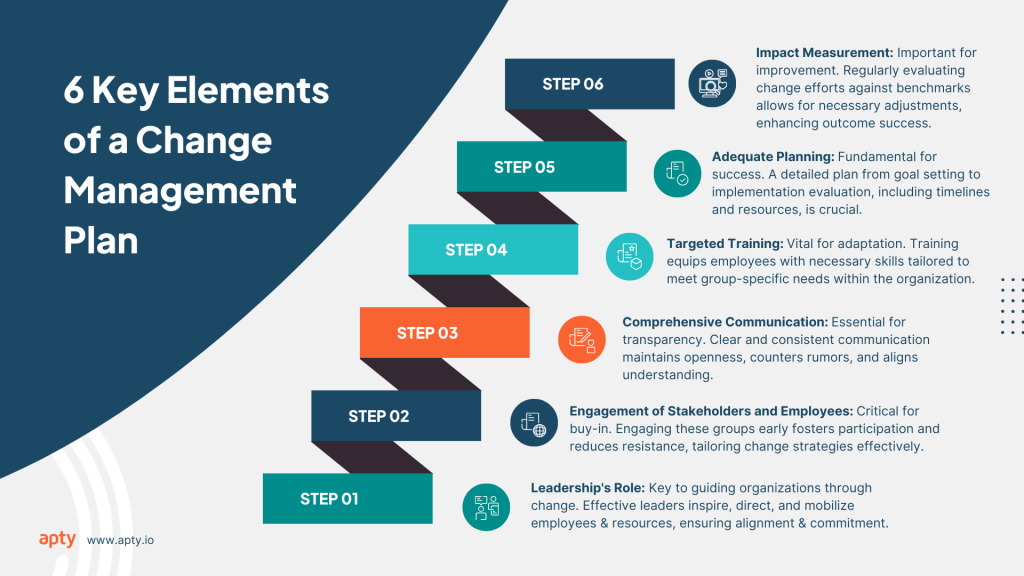
- Adequate Leadership and Support: Leadership is critical in steering the organization through change. Effective leaders provide direction, inspire confidence, and mobilize resources to support the transition. They act as champions for the change, facilitating alignment and commitment across all levels of the organization.
- Stakeholder and Employee Engagement: Engaging stakeholders and employees early and often in the change process is essential. This engagement ensures that those affected by the change have a voice in the process, fostering buy-in and reducing resistance. Understanding their concerns and expectations allows for more tailored and effective change strategies.
- Comprehensive Communication: Clear, consistent, and transparent communication is vital throughout the change process. Keeping everyone informed about the reasons for the change, its benefits, and its impact on their roles encourages a culture of openness and trust. Effective communication also helps in mitigating rumors and misinformation.
- Targeted Training: Equipping employees with the necessary skills and knowledge to adapt to new systems, processes, or technologies is crucial. Training should be designed to meet the specific needs of different groups within the organization, ensuring everyone is prepared for the change.
- Adequate Planning: A well-thought-out plan that covers the assessment of the desired change, from setting clear goals to measuring the implementation’s effectiveness, is crucial. This plan should detail every aspect of the change process, including timelines, milestones, and resource allocation.
- Impact Measurement: Regularly measuring the impact of change management efforts against predefined benchmarks allows for ongoing adjustment and improvement. According to Prosci’s Change Management study, projects with high-quality change management approaches are 6X more likely to meet or exceed their objectives, highlighting the importance of rigorous evaluation.
These elements form the backbone of a change management plan that addresses the logistical aspects of change and the human factors, ensuring the organization’s transition is as smooth and effective as possible. By focusing on these critical areas, organizations can significantly increase their chances of success, turning potential disruptions into opportunities for growth and development.
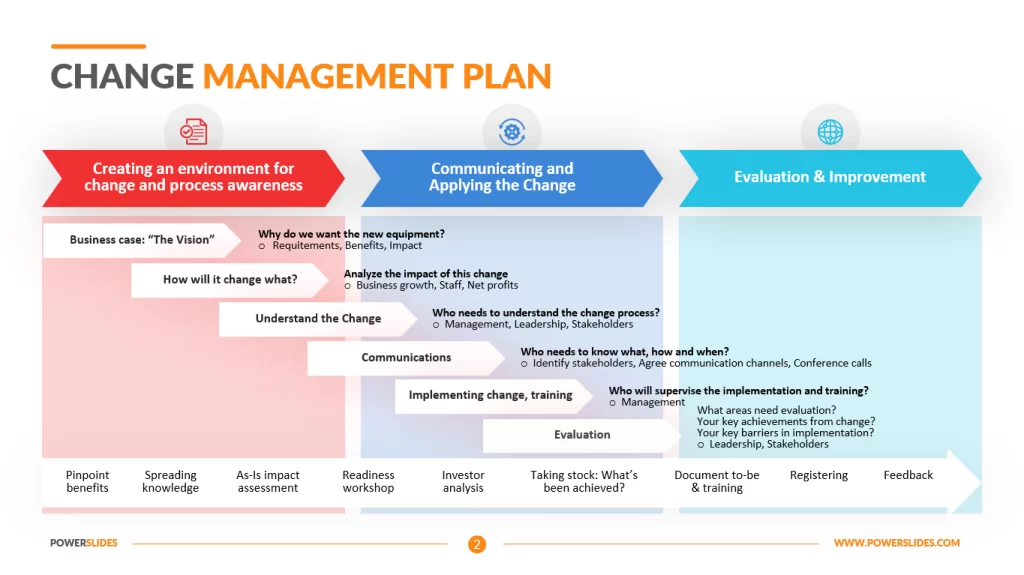
Best Practices for a Change Management Implementation Plan
The following are the best practices for a change management implementation plan:
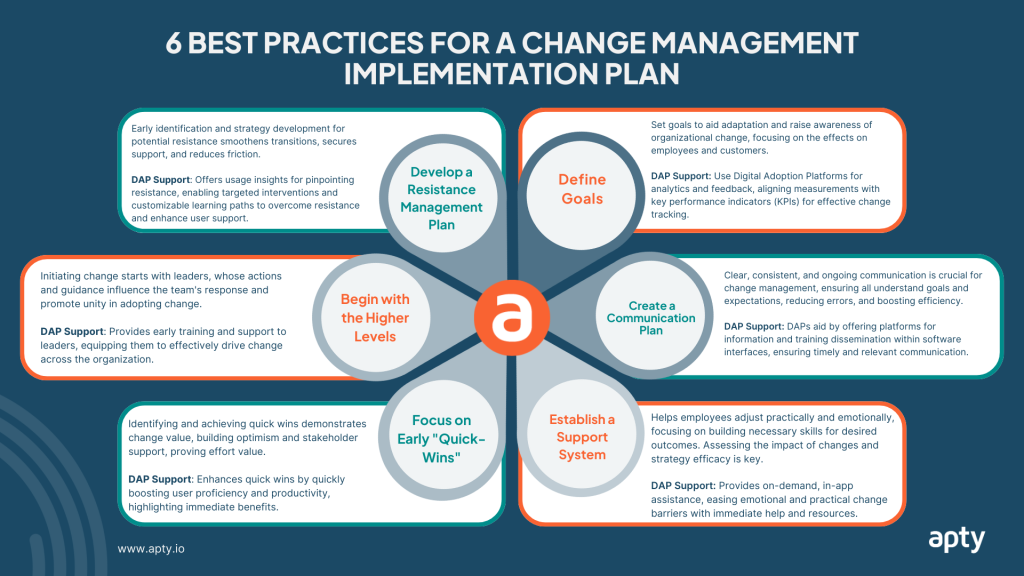
A. Define Goals
Setting clear goals is crucial when initiating a change management plan. These goals typically aim to help those affected by the change adapt and to increase organizational awareness of the change. Understanding the impact of the plan on employees and customers is essential. Defining clear key performance indicators (KPIs) is an effective way to track progress toward achieving your change management goals.
DAP Assistance: A Digital Adoption Platform can facilitate this by offering analytics and feedback tools to measure user engagement and the effectiveness of the change initiatives, directly aligning with set KPIs.
B. Create a Communication Plan
Effective communication is the backbone of any change management strategy. It should be clear, consistent, and continuous. Open communication channels with employees and stakeholders ensure that everyone understands the aims and expectations for the transformation, minimizing errors and enhancing efficiency.
DAP Assistance: DAPs can support this by providing platforms for disseminating information and training materials directly within the user interface of the software or systems being implemented, ensuring messages are timely and relevant.
C. Establish a Support System
A comprehensive support framework helps employees adjust to changes both practically and emotionally. This includes building the behavioral proficiency and technical skills needed to achieve desired outcomes. Assessing the business impact of changes and the efficacy of your change management strategy is also crucial.
DAP Assistance: DAPs offer on-demand, in-app support, and guidance, reducing the emotional and practical barriers to change by providing immediate assistance and resources.
D. Focus on Generating Early “Quick-Wins”
Identifying and achieving early successes can quickly demonstrate the value of the change to stakeholders and staff, building optimism and support. These “quick wins” help prove that the effort behind the change is worthwhile.
DAP Assistance: DAPs can highlight these early successes by rapidly improving user proficiency and productivity with new systems or processes, showcasing immediate benefits.
E. Begin with the Executives and Leadership Stakeholders
Change often impacts company culture and must start with the organization’s leaders. Their guidance and actions set the tone for the rest of the team’s response to changes. Leaders’ direct involvement promotes a unified approach to embracing and supporting change.
DAP Assistance: DAPs can be used to train and support leaders first, equipping them with the knowledge and tools to champion the change effectively throughout the organization.
F. Develop a Resistance Management Plan
Anticipating and managing resistance is key to smooth transitions. Identifying potential resistance early and developing strategies to address it can help secure support and minimize friction.
DAP Assistance: DAPs provide insights into usage patterns that can identify where resistance might occur, allowing for targeted interventions. They also offer customizable learning paths to address specific concerns and resistance, ensuring users feel supported and valued during the change process.
According to Isaiah Henry, CEO of Seabreeze Management Company, emphasizes the importance of building trust and support for new changes, stating:
“You’ll want to ensure your employees’ trust and support the new changes while minimizing resistance and friction. To do this, you need to provide your team with the training and skills they’ll need to succeed once the changes take effect. This is where an effective digital adoption platform comes in.”
DAPs embody this approach by ensuring that users are not just aware of how to use new systems but are proficient and confident in their use, thereby driving successful change management.
How can Apty Ensure Seamless Change Management?
In organizational transformation, introducing the right digital tools is pivotal for executing business tasks effectively, particularly during periods of change. A Digital Adoption Platform (DAP) like Apty stands at the forefront of facilitating digital transformation initiatives, ensuring users adopt new systems and thrive using them. Without such a platform, organizations risk digital transformation failure due to inadequate user adoption.
Apty is designed to ease employees into change, enhancing their understanding and acceptance of new processes or systems. By implementing change management in a structured manner, Apty promotes a positive attitude towards workplace transitions, significantly reducing friction and easing the path forward. Through its automation, Apty simplifies adopting new technology across an organization. This automation extends to training and onboarding processes, making the adoption journey less daunting and minimizing employee resistance.
Here’s how Apty facilitates a seamless change management experience:
- Increase Overall Employee Productivity: By providing interactive, on-demand guidance, Apty helps employees master new applications and processes quickly, leading to improved productivity.
- Reduce Training Costs and Deployment Time: Apty’s intuitive interface and targeted training materials reduce the need for extensive, costly training sessions, allowing for a faster rollout of new technologies.
- Implement Changes up to 3X Faster: With its streamlined onboarding and training processes, Apty enables organizations to implement changes more rapidly, keeping them agile and competitive.
- Overcome Employee Change Resistance: Through engaging, personalized learning experiences, Apty addresses common concerns and challenges, reducing hesitation and resistance among staff.
- Track and Measure Change Management Efforts: Apty’s analytics capabilities provide insights into user engagement and proficiency, allowing organizations to measure the success of their change management initiatives and make data-driven decisions.
Apty doesn’t just tackle the obstacles of employee resistance and frustration; it proactively enhances businesses’ management and operational efficiency. By improving the onboarding process, maximizing software ROI, ensuring compliance, and streamlining communication, Apty significantly boosts the efficacy of digital adoption strategies.
Organizations utilizing Apty can expect a notable increase in employee productivity and a substantially faster software adoption rate, underscoring Apty’s value in making organizational change management fool-proof and straightforward.
When Do Change Management Plans Fail?
Change management plans are crucial for guiding organizations through transition periods. However, not all plans lead to success. Several factors can derail the best-laid plans, leading to failure. Understanding these pitfalls is the first step in avoiding them and ensuring a smoother transition process.
A. Active Resistance: Resistance from employees is a common challenge. Changes threatening job security or disrupting familiar routines can lead to a lack of cooperation.
Apty Advantage: Apty tackles this issue head-on by facilitating clear communication about the benefits of the change, involving stakeholders in the planning process, and providing comprehensive training and support. This approach helps reduce resistance by addressing concerns directly and clarifying the benefits of change to all involved.
B. Poor Communication: Effective communication is the backbone of successful change management. Without it, confusion and disengagement can spread.
Apty Advantage: Apty ensures clear, consistent, and inclusive communication. Through its digital adoption platform, Apty provides timely updates and feedback loops, allowing for transparent communication and the opportunity for employees to voice concerns or ask questions.
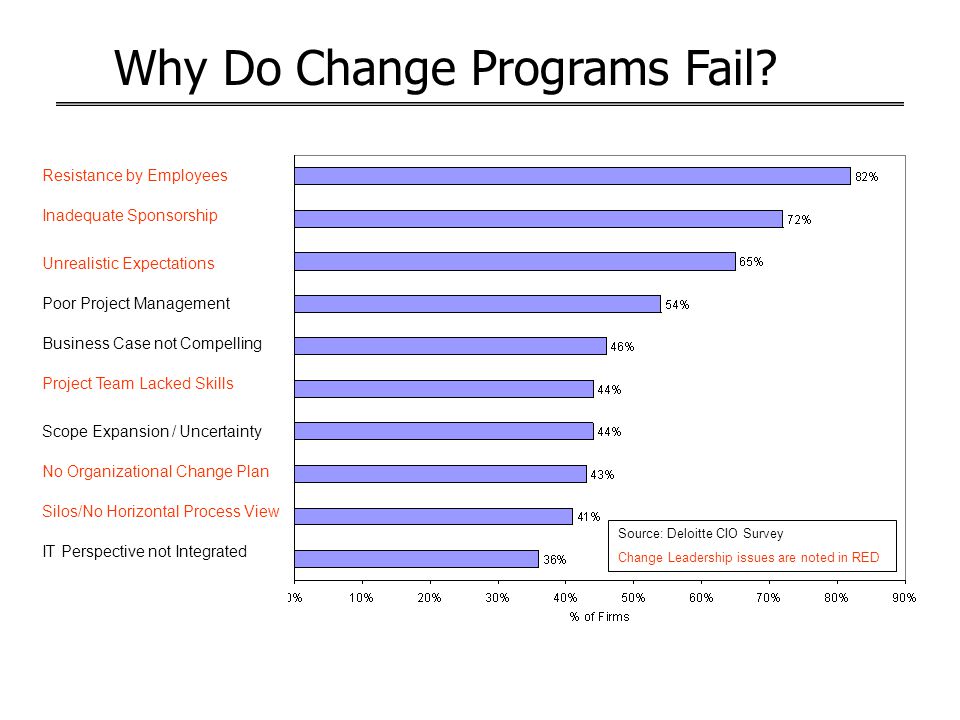
C. Inadequate Planning: Success in change management demands meticulous planning. A lack of thoroughness can leave gaps in the strategy, leading to ineffective implementation.
Apty Advantage: Apty supports detailed planning processes by offering insights into how changes affect different parts of the organization. This enables precise goal setting, timeline establishment, and resource allocation, ensuring comprehensive planning.
D. Lack of Leadership Support: Leadership buy-in is essential for change management success. Leaders play a pivotal role in motivating the workforce, providing resources, and championing change.
Apty Advantage: Apty engages leaders by demonstrating the strategic advantages of its platform, ensuring they have the visibility and tools needed to support the change. This includes analytics to monitor progress and the impact of change, reinforcing the leaders’ role in driving success.
E. Inadequate Resources: Financial, technological, and temporal resources are necessary for the fruition of change plans. When resources fall short, so does the plan.
Apty Advantage: Apty aids in optimizing resource allocation by streamlining training and onboarding, reducing the need for extensive resources. Its efficiency in facilitating change minimizes costs and deployment time, ensuring the necessary resources are utilized effectively.
Change management plan template
Change management is focused on successfully transitioning people through a change rather than merely the mechanics of the change. A Change Management project plan template might make your job easier if you participate in change management operations. Using such a well-defined and ready-to-use template can relieve you of a significant amount of effort.
Conclusion
When you introduce new technology as part of your change initiative, you want to make sure your employees are using them to their fullest potential. Employee proficiency, productivity, and engagement should be increased as a result of the new software. Another way to improve efficiency and productivity is to streamline the digital workflow.
If you adopt the technology correctly, employees will naturally become more skilled and more productive. When you tie in Apty DAP with your change management plan, your change management will be streamlined, end-to-end.

